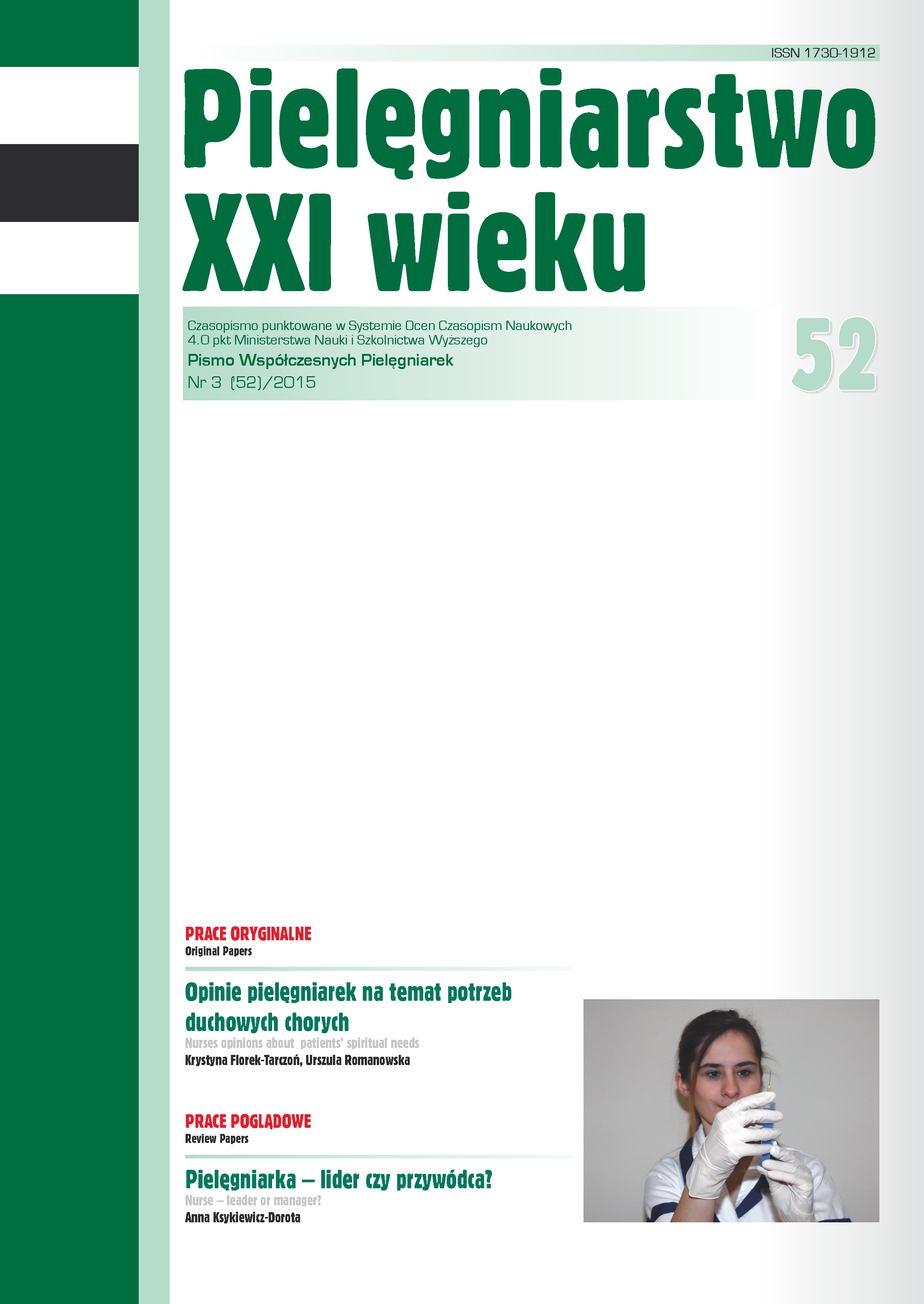Knowledge of nurses about the malignant melanoma and it prevention
DOI:
https://doi.org/10.12923/p21w-2015-3/26Keywords:
melanoma, prevention, health behaviorsAbstract
KNOWLEDGE OF NURSES ABOUT THE MALIGNANT MELANOMA AND IT PREVENTION
Introduction. The number of melanoma cancer cases has increased during the last decade in most countries around the world. Taking preventive measures plays a huge role in an early diagnosis of skin cancer. Nurses with knowledge about melanoma can prove to be very successful in fighting the disease.
Aim. The aim of the study was to determine the level of nurses’ knowledge about melanoma and health behaviors.
Materials and methods. The research was conducted in University Children’s Hospital in Kraków in 2014. Some 100 nurses, selected at random, filled out a questionnaire of the authors’ own making.
Results. Some 79% of the respondents pointed to melanoma skin cancer as the most common form of a tumor. More than a half of the respondents, namely 56% of them, believe that melanoma cancer is a life-threatening condition. Various research studies show that dietary habits, behaviors and preventive health practices, as well as a positive mental attitude, is maintained at the secondary level.
Conclusions. The level of nurses’ knowledge about the prevention of cutaneous melanoma is average, namely 77%.
References
1. Rudkowski P. Złośliwe nowotwory skóry. Gdańsk: Via Medica; 2011.
2. Didkowska J, Wojciechowska U, Tarkowski W, i wsp. Nowotwory złośliwe w Polsce 2009 roku. Centrum Onkologii – Instytut w Warszawie, 2011.
3. Rutkowski P, Wysocki P, Nowecki Z. Czerniak skóry- zasady postępowania diagnostyczno-terapeutycznego w 2013 roku. Przegląd Dermatologiczny. 2013; 100: 1-15.
4. Krakowy Rejestr Nowotworowy [Data cytowania 22.07.2014] dostępny pod adresem: http://onkologia.org.pl/czerniak-skory-c43/.
5. Kordka R. Onkologia. Podręcznik dla studentów i lekarzy. Via Medica Gdańsk 2013.
6. Kuszuba A, Zieliński KW. Choroby i nowotwory skóry wywołane promieniowaniem ultrafioletowym. Łódź: wyd. ADI; 2004:177-211.
7. Murawa P, Murawa DP. Współczesne metody diagnostyki i leczenia czerniaka skóry. Postępy Dermatologii i Alergologii XIX. 2002; 3:166.
8. Wysocka J, Komorowski A, Wysocki W, i wsp. Czerniak skóry. Nowa klasyfikacja TNM (2010 r.) Medycyna Praktyczna Onkologia. 2010;6:1-9.
9. Diao DY, Lee TK. Sun-protective behaviors in populations at high risk for skin cancer. Psychol Res Behav Manag. 2013;7: 9-18.
10. Freak J. Nurses’ role in public education on the risks of skin cancer. Nurs Times. 2003;99(25):30-32.
11. Zalewska A, Cylkowska-Nowak M. Zdrowie skóry a słonce- próba diagnozy wiedzy oraz wybranych postaw. Nowiny Lekarskie. 2012; 81(3):214-218.
12. Kasza E. Wiedza pacjentów na temat czynników ryzyka rozwoju czerniaka skóry. Teoria i praktyka pielęgniarki i położnej. 2014;10:6-10.
13. Borkowska B, Kardynał A, Słowińska M, i wsp. Czerniak u osób korzystających z urządzeń opalających emitujących promienie UV (solariów), Przegląd Dermatologiczny. 2013;100:345-352.
14. Krajewska-Kułak E, Kowalewska B, Wróblewska K i wsp. Postawa studentów wobec korzystania z solarium i kąpieli słonecznych. Problemy Pielęgniarstwa. 2011; 19(3): 322-328.
15. Góralska A, Błaszczyk J. Charakterystyka czynników ryzyka rozwoju znamion melanocytowych i czerniaka u pacjentów zgłaszających się do dermatologa w celu oceny zmian barwnikowych. Przegląd Dermatologiczny. 2013;100:86-95.
16. Żelasko A. Wiedza studentów kierunków medycznych na temat profilaktyki, rozpoznania i leczenia czerniaka skóry. Problemy Pielęgniarstwa 2014;22(2): 216- 222.
17. Kowalewska B, Krajewska-Kułak E, Wrońska I. i wsp. Wiedza pielęgniarek i położnych na temat chorób skóry. Problemy Pielęgniarstwa. 2011;19(3): 315-321.
Downloads
Published
Issue
Section
License
Copyright (c) 2015 Anna Trzaskuś, Przemysław Zając, Aneta Grochowska, Iwona Bodys-Cupak (Autor)

This work is licensed under a Creative Commons Attribution-NonCommercial-NoDerivatives 3.0 Unported License.




